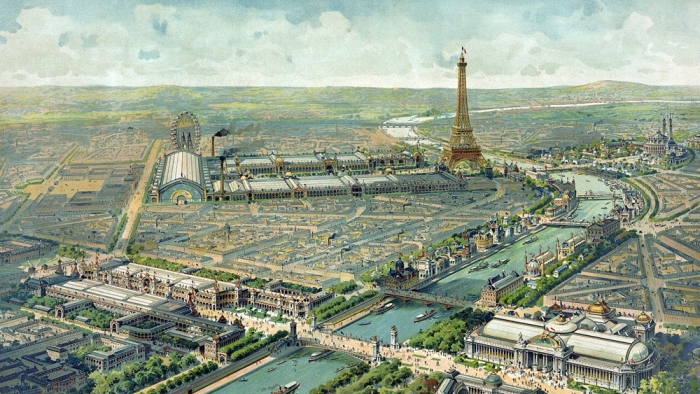While it would be easy to forget or even not know this expo occurred, especially in the context of the current global pandemic, war, and economic crisis, they are rather important events for the nations of the world. These global conventions, which date back to the 19th century, showcase each country’s achievements in a variety of fields from science to technology and culture.
When one looks at the 2020 pavilions, however, one does not see a diverse field of buildings representing various cultures, people, and nations, instead one sees only a field of monolithically abstract buildings which, for the vast majority, bear little to no resemblance to any particular country.
The United States Pavilion, for example, is a glorified trapezoid lacking any defining features. If one gets close enough to the building, they will discover that the wall is embedded with stars, but this is impossible to see from a distance and dozens of countries have stars as a national symbol.

The United Kingdom Pavilion is an even greater disappointment. Jutting out of the ground like a collection of pipes on a truck, this ‘interactive’ expo is designed to display input from various visitors on the façade of the building. In doing this, it represents the various visitors of the expo more than the United Kingdom.

The list could go on and on, and with very few exceptions it would be impossible to determine which nation each pavilion belonged to. Hungary’s Pavilion was somewhat of an exception. It is more organic than abstract and at least represents the focus of the exposition: Hungary’s aqua roots and thermal spas.
This situation, where national pavilions seem to reject the very identity they are supposed to represent, was not always the case. If one looks at the pavilions from the 19th and early 20th centuries, they will see a stark contrast with the pavilions of today. Instead of unidentifiable pavilions, these early expositions were built to be the architectural epitome of their respective nations.
The 1900 Paris World Expo, known then as the Exposition Universelle, is a great example of this original format of national pavilions.
 The United States’ pavilion, for example, couldn’t be more different than the 2020 pavilion. Modeled after the United States Capitol’s dome, its ornate structure embodied America’s unique style of Neo-Classical and Beaux-Arts architecture. To further represent the spirit of America, a mounted statue of George Washington was placed at one of the dome’s entryways.
The United States’ pavilion, for example, couldn’t be more different than the 2020 pavilion. Modeled after the United States Capitol’s dome, its ornate structure embodied America’s unique style of Neo-Classical and Beaux-Arts architecture. To further represent the spirit of America, a mounted statue of George Washington was placed at one of the dome’s entryways.
In like fashion, Russia’s exposition design was based on the architecture of the Kremlin, Italy’s on Venice’s St. Mark’s Basilica, and Germany’s was based in the style of a traditional German town hall.
 Hungary’s pavilion was similarly built to represent Hungary and was inspired by Corvin Castle. A replica of the recently built St. Stephen’s Hall was also present at the Hungary’s exhibition and won the Grand Prix of the World Exposition.
Hungary’s pavilion was similarly built to represent Hungary and was inspired by Corvin Castle. A replica of the recently built St. Stephen’s Hall was also present at the Hungary’s exhibition and won the Grand Prix of the World Exposition.
The fact that most people can still recognize their countries pavilion from 1900 tells us that the architecture associated with these countries have not changed. In fact, most of the styles that the pavilions were built in were purposefully done in a historicist style which in turn makes them timeless, recognizable by any generation of a community.
What has changed in the last century is the mindset of those who planned and designed these buildings. Our society has regressed from building structures which clearly represented people, nations, and identities, to building structures which represent abstract and unrecognizable ideas.
While this shift can be seen with most buildings built after the Second World War, this change becomes especially glaring when we look at our World Expo pavilions.
It is so glaring because it exposes the degree to which we have become incapable of constructing representative buildings. Even when the very purpose of the building is to represent a specific identity or culture, our architectural community is so entrenched in the rejection of traditional design and character that they are unable to construct one.
For certain countries, like Germany whose current ruling ideology rejects the notion of German culture in favor of multiculturalism, these unidentifiable and abstract designs are fitting. It accurately demonstrates that their nation no longer represents a distinct people or culture, but rather a modern conglomeration of formless individuals.
But for countries that wish to protect and enrich their own cultural tradition, it is inexcusable that they allow the design of their own pavilions to reject these treasures. The World Exposition is a place where a country, no mater the size, wealth, or influence, can show the world the rich tradition that they possess.
We must also reconsider the direction of architecture in general, and whether we are satisfied with the monotonous direction it has taken. When we erect any building which purposefully eschews our collective aesthetic inheritance, we disrespect our country and do ourselves a disservice.









